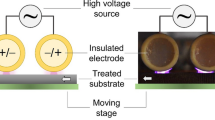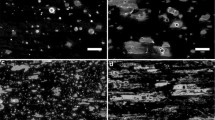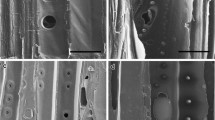Abstract
The surface properties of wood particles are one of the key factors for the development of mechanical and physical properties of particleboards. Particles were treated with plasma at atmospheric pressure with ambient air in order to enhance the polarity of wooden surfaces. One-layer particle boards were produced from the plasma-treated particles by using 3, 5, and 8 % urea formaldehyde adhesive (related to the particles). For all adhesive ratios, internal bond strength was increased by approximately 0.1 MPa compared to the respective controls. The modulus of rupture, modulus of elasticity and water related properties were only improved compared to the respective controls at the lowest adhesive content. It is therefore concluded that the plasma treatment can improve the bonding quality and water related properties of particleboards particularly at low adhesive contents.





Similar content being viewed by others
References
Acda MN, Devera EE, Cabangon RJ, Ramos HJ (2012) Effects of plasma modification on adhesion properties of wood. Int J Adhes Adhes 1–2:70–75
Avramidis G, Hauswald E, Lyapin A, Militz H, Viöl W, Wolkenhauer A (2009) Plasma treatment of wood and wood-based materials to generate hydrophilic or hydrophobic surface characteristics. Wood Mater Sci Eng 4:52–60
Aydin I, Demirkir C (2010) Activation of spruce wood surfaces by plasma treatment after long terms of natural surface inactivation. Plasma Chem Plasma P 30:697–706
Burrows CH (1961) Some factors affecting resin efficiency in flake board. Forest Prod J 11:27–33
Carll C (1998) Flake storage effects on properties of laboratory-made flakeboards. Res. Note FPL-RN-267. Madison, US Dept. of Agriculture, Forest Service, Forest Products Laboratory
Chambers JM (1983) Graphical methods for data analysis. Wadsworth, Belmont
Christensen RL, Robitschek P (1974) Efficiency of resin-wood particle blending. Forest Prod J 24:22–25
EN 120 (1992) Wood-based panels: determination of formaldehyde content: extraction method called the perforator method. European Standard
EN 310 (1993) Wood based panels—determination of modulus of elasticity in bending and of bending strength. European Standard
EN 317 (1993) Particleboards and fibreboards—determination of swelling in thickness after immersion in water. European Standard
EN 319 (1993) Particleboards and fibreboards—determination of tensile strength perpendicular to the plane of the board. European Standard
EN 717-2 (1994) Wood-based panels—determination of formaldehyde release—Part 2: formaldehyde release by the gas analysis method. European Standard
EN 717-3 (1996) Wood-based panels—determination of formaldehyde release—Part 3: formaldehyde release by the flask method. European Standard
EN 312 (2010) Particleboards—specifications. European Standard
EPF (2012) Annual report 2011–2012. European Panel Federation, Brussels
Grigoriou (1981) Der Einfluß verschiedener Holzarten auf die Eigenschaften dreischichtiger Spanplatten und deren Deckschichten. Holz Roh Werkst 39:97–105
Hameed M, Behn C, Roffael E, Dix B (2005) Wettability of recycling shavings and “fresh” wood shavings with various adhesive agents. Holz Roh Werkst 63:394–395
IARC (2006) International Agency for Research of Cancer—Formaldehyde, 2-Butoxyethanol and 1-tert-Butoxy-2-propanol, IARC monographs on the evaluation of carcinogetic risks to humans, Vol. 88. World Health Organisation, Lyon
Klarhöfer L, Frerichs M, Maus-Friedrichs W, Kempter V, Viöl W (2005) Investigation of pure and plasma treated spruce with surface analytical techniques. In: Militz H, Hill C (eds) European conference on wood modification, Germany., pp 339–345
Lehmann WF (1965) Improved particleboard through better resin efficiency. Forest Prod J 15:155–161
Lehmann WF (1968) Resin distribution in flakeboard shown by ultraviolet light photography. Forest Prod J 18:32
Lehmann WF (1970) Resin efficiency in particleboard as influenced by density, atomization, and resin content. Forest Prod J 20:48–54
Myers GE (1984) How mole ratio of UF resin affects formaldehyde emission and other properties: a literature critique. Forest Prod J 34:35–41
Que Z, Furuno T, Katoh S, Nishino Y (2007) Effects of urea–formaldehyde resin mole ratio on the properties of particleboard. Build and Environ 42:1257–1263
Roffael E (1987) Effect of drying conditions of scots pine chips on their gluability with UF resins. Holz Roh Werkst 45:449–456
Roffael E, Behn C (2012) On the influence of binder content in particleboards bonded with resins of high and low molar ratio on the formaldehyde release measured by the perforator method. Eur J Wood Prod 70:819–822
Sari B, Nemli G, Ayrilmis N, Baharoglu M, Bardak S (2013) The influences of drying temperature of wood particles on the quality properties of particleboard composite. Dry Technol 31:17–23
Scholz G, Nothnick E, Avramidis G, Krause A, Militz H, Viöl W, Wolkenhauer A (2010) Adhesion of wax impregnated solid beech wood with different glues and by plasma treatment. Eur J Wood Prod 68:315–321
Wilson JB, Krahmer RL (1976) Particleboard—microscopic observations of resin distribution and board fracture. Forest Prod J 26:42–45
Wolkenhauer A, Avramidis G, Cai Y, Militz H, Viöl W (2007) Investigation of wood and timber surface modification by dielectric barrier discharge at atmospheric pressure plasma. Process Polym 4:S470–S474
Wolkenhauer A, Militz H, Viöl W (2008) Increased PVA-Glue adhesion on particle board and fibre board by plasma treatment. Holz Roh Werkst 66:143–145
Wolkenhauer A, Avramidis G, Hauswald E, Militz H, Viöl W (2009) Sanding vs. plasma treatment of aged wood: A comparison with respect to surface energy. Int J Adhes Adhes 29:18–22
Acknowledgments
This study was funded by the FNR (Fachagentur für Nachwachsende Rohstoffe, support code 22005410). Furthermore, we are thankful to Glunz AG and BASF SE for providing the material.
Author information
Authors and Affiliations
Corresponding author
Rights and permissions
About this article
Cite this article
Altgen, D., Bellmann, M., Wascher, R. et al. Enhancing mechanical properties of particleboards using plasma treated wood particles. Eur. J. Wood Prod. 73, 219–223 (2015). https://doi.org/10.1007/s00107-015-0879-z
Received:
Published:
Issue Date:
DOI: https://doi.org/10.1007/s00107-015-0879-z




